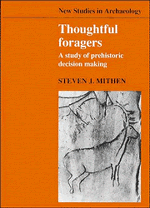Book contents
- Frontmatter
- Contents
- List of figures
- List of tables
- Preface
- 1 Introduction
- PART ONE LEARNING FROM THE PRESENT
- PART TWO MESOLITHIC FORAGING AND SOCIETY
- 4 Broken bones and buried bodies: patterns in the archaeological record
- 5 Gearing up with methodological tools: building a simulation model
- 6 Decision making in the Mesolithic: multiple action replays
- PART THREE UPPER PALAEOLITHIC ART AND ECONOMY
- Bibliography
- Index
5 - Gearing up with methodological tools: building a simulation model
Published online by Cambridge University Press: 04 August 2010
- Frontmatter
- Contents
- List of figures
- List of tables
- Preface
- 1 Introduction
- PART ONE LEARNING FROM THE PRESENT
- PART TWO MESOLITHIC FORAGING AND SOCIETY
- 4 Broken bones and buried bodies: patterns in the archaeological record
- 5 Gearing up with methodological tools: building a simulation model
- 6 Decision making in the Mesolithic: multiple action replays
- PART THREE UPPER PALAEOLITHIC ART AND ECONOMY
- Bibliography
- Index
Summary
Between my finger and my thumb
The squat pen rests.
I'll dig with it.
Seamus Heaney, ‘Digging’In his poem Seamus Heaney reflects upon his father digging potatoes: By God, the old man could handle a spade. Just like his old man.’ He, however, chose to work with the pen. Times had changed for the Heaney family as indeed they have in archaeology. Not long ago, when archaeologists were faced with the types of problems I have outlined in the previous chapter, their reaction would have been to ‘dig more sites’. More recently an alternative reaction has been to seek a total immersion in theory. We now realise that more data and theory do not necessarily bring more understanding and explanation by themselves. We need the link between these, new methodology. Tools other than picks and shovels are required. So, with apologies to Heaney: ‘Between my finger and my thumb the computer programme rests. I'll dig with it.’ Of course I am not implying that there isn't a need for new excavations. Just as poets need potatoes, simulation models need good archaeological data and both must continue to be dug from the ground.
The simulation model, which I see as a methodological tool, will follow the idealised encounter foraging system I proposed above. It can be divided into three components: a model for the hunting process, a model for the post-glacial environment and a model for decision making by the hunters.
- Type
- Chapter
- Information
- Thoughtful ForagersA Study of Prehistoric Decision Making, pp. 109 - 151Publisher: Cambridge University PressPrint publication year: 1990

